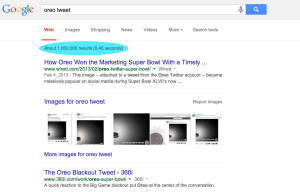Did you know Wendy’s upcoming Super Bowl ad was inspired by the recent Twitter spat (read: roast) of a user who challenged the freshness of the fast food chain’s beef?
Following a few days of roasting Twitter users, Wendy’s conducted research and that found seven in 10 consumers did not believe it really serves fresh beef. Based on this research and the Twitter roast earlier this year, the upcoming commercial educates consumers on Wendy’s beef and jokingly offers several “practical” uses of frozen burgers, none of which include eating.
Social media offers an amazing opportunity to connect directly with your audience, engage in real-time conversations, and most importantly, listen to what the audience is saying about your brand, your competitors, and the industries and categories where you compete. It’s no surprise that social media has had a massive impact on building strong brands, creating compelling customer experiences, and generating loyal brand advocates!
That said, how you manage and engage audiences on social media is not a static process and it is certainly not straightforward. The way people engage with content and brands on social media is dynamic and evolves continuously. Furthermore, your approach to social media must be tailored to your audience and customized based on a variety of variables, such as the profile of your target audience and their preferences, device penetration, platform usage, and so on. It’s critical to have a deep understanding of these data points to set up a successful social media strategy.
Let’s start with your audience. Who do you think are the heaviest users of social media? Contrary to what you may have been told, social media power users are not dominated by Millennials. It’s actually Generation X (ages 35-49) who spend the most time on social media — almost 7 hours per week! Millennials, on the other hand, spend just over 6 hours per week.
They’re female, 25% of their time online is spent on social media (vs.19% of males), and they reach across cultures. They’re likely to be on Facebook on Sundays via smartphone, while watching primetime television. — Sean Casey, President of Nielsen Social

These are just some of the many promising findings provided in the recent 2016 Nielsen Social Media Report. Many of the fascinating takeaways do not come from the data itself, but from the actionable insights that can be derived from the data in this report.
Knowing who these potential brand/media activists are is only the half of it—the most important part of winning them over is understanding where and how to connect with them successfully. — Sean Casey, President of Nielsen Social
Let’s take a look at several actionable data points from the 2016 Nielsen Social Media Report: The Social Media Landscape. Click here for the full report.
4 Actionable Insights from the 2016 Nielsen Social Media Report
1. Timing and frequency do matter

I often read that brands miss out by only tweeting Monday through Friday, and this data proves that point. Brands are missing out on the most active days on social media if they take a break on the weekend. Take for example Facebook’s activity: it skyrockets on Sundays. In fact, it’s five times busier than Monday and eight times busier than Friday! If your brand only posts one day a week on Facebook, Sunday is the best day to do so.
The busiest days on Twitter are Sunday, Wednesday, and Thursday, so consider optimizing your Twitter strategy for heavier usage on these days.
2. Story must be simple and clear

The content that you are sharing on social media should tell the story of your company’s products or services, first and foremost. Thirty-nine percent of heavy social users believe that finding out about products and services is an important reason for using a social network — it was ranked more important than any other usage. They also like receiving exclusive offers, coupons, and other discounts. With that in mind, it is really important to make it easy for potential brand advocates to find information about their products and services across several social media platforms.
3. Power users are big spenders

Did you know that one-fifth of U.S. adults spent $ 1000 or more on internet purchases in the past year? In fact, social media users play an important role on this statistic, being active online purchasers — 41 percent of adults that spend up to 2 hours a day on social media spent $ 500 or more on internet purchases in the past year, versus 22 percent of non-social media users.
Especially if you are an e-commerce company, social media is an important component of your marketing strategy. Not only to generate brand awareness but also to be part of your audience’s consideration that will ultimately drive their purchase decisions.
4. Messaging must be ruthlessly consistent across channels

Forty-six percent of non-social media users have made an internet purchase in the past year. While social media is an important part of your brand strategy, you shouldn’t be focusing solely on that channel. For e-commerce companies, in particular, adopting a cross-channel strategy is essential to capitalize on your entire audience segment, else your brand isn’t speaking to 46 percent of potential purchasers (non-social media users).
Your mission is to get the right message, to the right customer, via the right channel, and at the right time. In order to do this, your organization must have a unified brand message across all channels. Whether your customers find out about your products through social media, your website, or advertisements, the messaging, feeling, and story should be the same.
Learn more about how to bring simplicity, clarity, and alignment to your brand’s Story, Strategy, and Systems in our latest eBook Transformational Marketing: Moving to the TopRight.
Digital & Social Articles on Business 2 Community(19)




